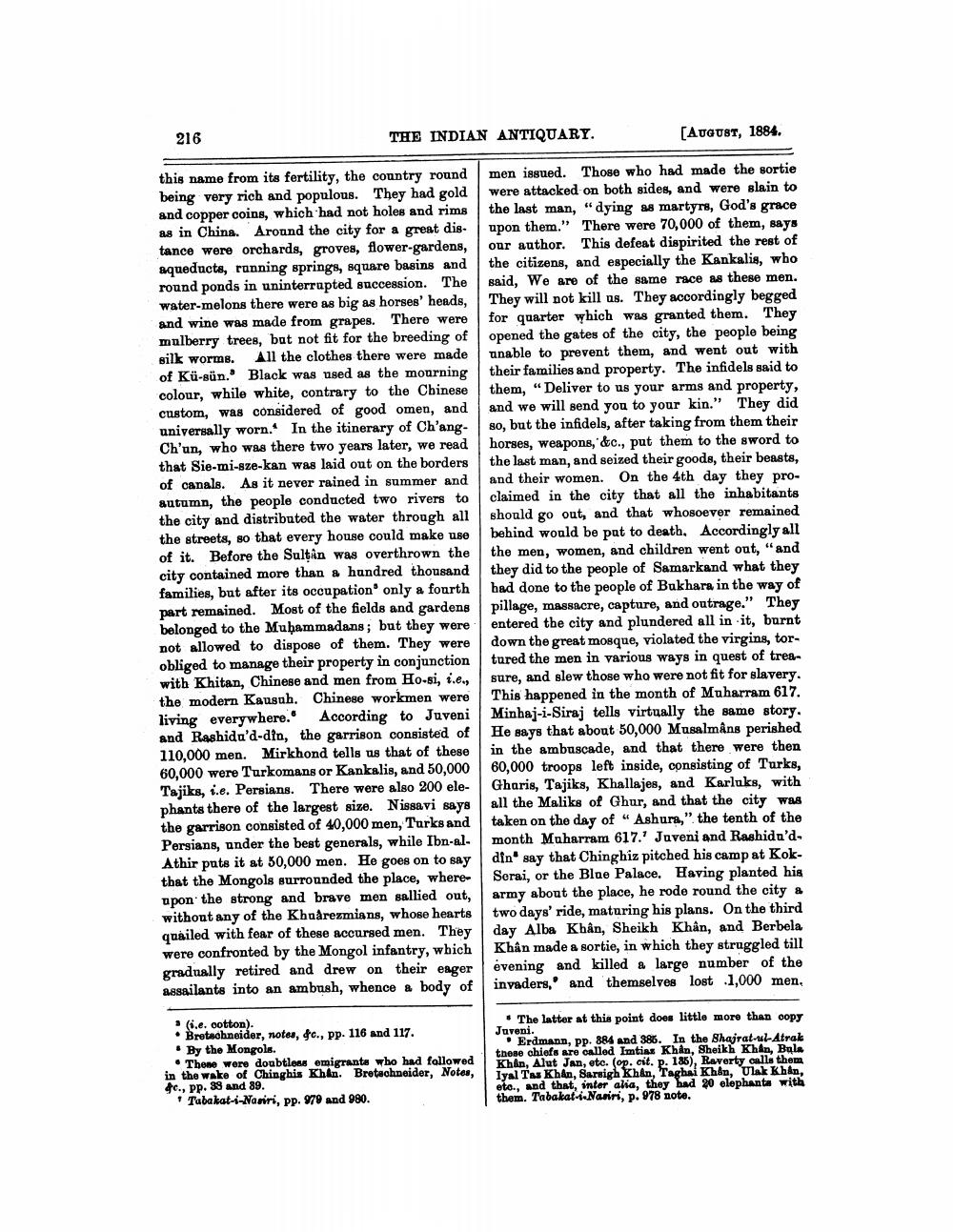________________
216
THE INDIAN ANTIQUARY.
this name from its fertility, the country round being very rich and populous. They had gold and copper coins, which had not holes and rims as in China. Around the city for a great distance were orchards, groves, flower-gardens, aqueducts, running springs, square basins and round ponds in uninterrupted succession. The water-melons there were as big as horses' heads, and wine was made from grapes. There were mulberry trees, but not fit for the breeding of silk worms. All the clothes there were made of Kü-sün. Black was used as the mourning colour, while white, contrary to the Chinese custom, was considered of good omen, and universally worn. In the itinerary of Ch'angCh'un, who was there two years later, we read that Sie-mi-sze-kan was laid out on the borders of canals. As it never rained in summer and autumn, the people conducted two rivers to the city and distributed the water through all the streets, so that every house could make use of it. Before the Sultan was overthrown the city contained more than a hundred thousand families, but after its occupation only a fourth part remained. Most of the fields and gardens belonged to the Muhammadans; but they were not allowed to dispose of them. They were obliged to manage their property in conjunction with Khitan, Chinese and men from Ho-si, i.e., the modern Kausuh. Chinese workmen were living everywhere. According to Juveni and Rashida'd-din, the garrison consisted of 110,000 men. Mirkhond tells us that of these 60,000 were Turkomans or Kankalis, and 50,000 Tajiks, i.e. Persians. There were also 200 elephants there of the largest size. Nissavi says the garrison consisted of 40,000 men, Turks and Persians, under the best generals, while Ibn-alAthir puts it at 50,000 men. He goes on to say that the Mongols surrounded the place, whereupon the strong and brave men sallied out, without any of the Khuârezmians, whose hearts quailed with fear of these accursed men. They were confronted by the Mongol infantry, which gradually retired and drew on their eager assailants into an ambush, whence a body of
(i.e. cotton).
• Bretschneider, notes, &c., pp. 116 and 117.
[AUGUST, 1884.
men issued. Those who had made the sortie were attacked on both sides, and were slain to the last man, "dying as martyrs, God's grace upon them." There were 70,000 of them, says our author. This defeat dispirited the rest of the citizens, and especially the Kankalis, who said, We are of the same race as these men. They will not kill us. They accordingly begged for quarter which was granted them. They opened the gates of the city, the people being unable to prevent them, and went out with their families and property. The infidels said to them, "Deliver to us your arms and property, and we will send you to your kin." They did so, but the infidels, after taking from them their horses, weapons, &c., put them to the sword to the last man, and seized their goods, their beasts, and their women. On the 4th day they proclaimed in the city that all the inhabitants should go out, and that whosoever remained behind would be put to death. Accordingly all the men, women, and children went out, "and they did to the people of Samarkand what they had done to the people of Bukhara in the way of pillage, massacre, capture, and outrage." They entered the city and plundered all in it, burnt down the great mosque, violated the virgins, tortured the men in various ways in quest of treasure, and slew those who were not fit for slavery. This happened in the month of Muharram 617. Minhaj-i-Siraj tells virtually the same story. He says that about 50,000 Musalmâns perished in the ambuscade, and that there were then 60,000 troops left inside, consisting of Turks, Gharis, Tajiks, Khallajes, and Karluks, with all the Maliks of Ghur, and that the city was taken on the day of "Ashura," the tenth of the month Muharram 617.' Juveni and Rashida'ddin say that Chinghiz pitched his camp at KokSerai, or the Blue Palace. Having planted his about the place, he rode round the city a army two days' ride, maturing his plans. On the third day Alba Khân, Sheikh Khân, and Berbela Khân made a sortie, in which they struggled till evening and killed a large number of the invaders, and themselves lost 1,000 men.
By the Mongols.
These were doubtless emigrants who had followed in the wake of Chinghis Khan. Bretschneider, Notes, 4c., pp. 39 and 89.
Tabakat-i-Nasiri, pp. 979 and 980.
The latter at this point does little more than copy
Juveni.
Erdmann, pp. 884 and 385. In the Shajrat-ul-Atrak these chiefs are called Imtiaz Khan, Sheikh Khan, Bula Khan, Alut Jan, etc. (op. cit. p. 185), Raverty calls them Iyal Tas Khan, Sarsigh Khan, Taghai Khan, Ulak Khan, etc., and that, inter alia, they had 20 elephants with them. Tabakat-i-Nasiri, p. 978 note.




